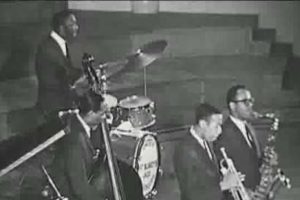Roy Eldridge was known as Little Jazz because he was only 5 feet 6 inches tall. It is a cliche, but true: The small man had a very large influence.
NPR says that he was known for “his soulful style and great competitiveness, not to mention his ridiculous chops.”
The first paragraph of the profile, which was written for his centennial, tells us just how important Eldridge was: It says that many jazz historians – the people who really know what they are talking about – call Eldridge the link between Louis Armstrong and Dizzy Gillespie. Wikipedia elaborates a bit by saying that Eldridge’s influenced Gillespies playing in the upper register.
David Roy Eldridge was born on January 11, 1911 in Pittsburgh in a music family. He inherited his mother’s ability to play by ear. Eldridge began on drums and was convinced to switch to valved trumpet by his older brother, also a musician,who was impressed by Roy’s bugle playing in a church band.
The Wikipedia profile describes a man who was fiercely competitive and, toward the end of his career, volatile. Eldridge’s intensity and his importance to the development of jazz are the themes of the obituary in The New York Times in 1989. Two quotes characterized how the jazz community felt about him:
”Roy took as his point of departure the fantastic style of the middle Armstrong period,” Ross Russell, a jazz record producer and historian, wrote in 1949. ”But Roy’s trumpet went beyond Louis in range and brilliance. It had greater agility. His style was more nervous. His drive was perhaps the most intense jazz has ever known.”
and
”God gives it to some and not others,” Ella Fitzgerald once said, speaking of Mr. Eldridge. ”He’s got more soul in one note than a lot of people could get into the whole song.”
Eldridge was an important figure in another way. He integrated bands such as those led by Gene Krupa and Artie Shaw.
Heart problems forced in to retire as a trumpeter in 1980, though he sometimes performed as a drummer and a singer.
Above is “I Can’t Get Started.” The early television image is awful, but the playing is great. The old television show — it’s Art Ford’s Jazz Party — gives it a great sense of time and place. Below is “Sunday.” The NPR post offers recommendations on important Eldridge recordings.










